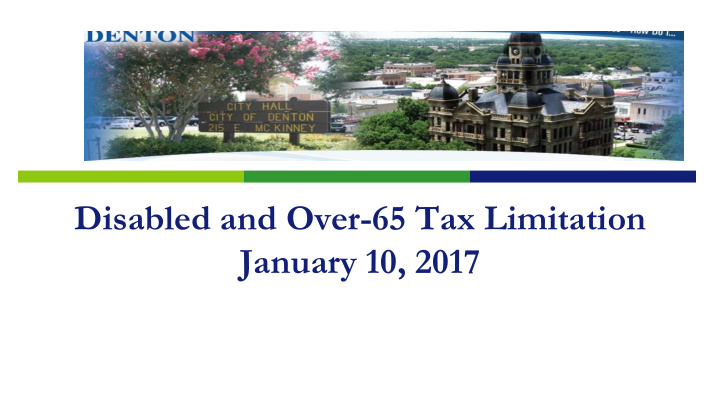



Disabled and Over-65 Tax Limitation January 10, 2017
Purpose of Work Session Present Information on the Over 65 and Disabled Tax Limitation and estimated financial impacts 2
Tax Year 2016 Exemptions Exemptions Value Amount Tax Amount Percentage Tax Abatements $ 131,784,454 $ 902,394 15.9% Disabled Persons and Veterans $ 50,492,373 $ 345,747 6.1% Freeport $ 208,186,573 $ 1,425,558 25.1% Homestead $ 88,848,080 $ 608,387 10.7% Historical Property $ 4,736,286 $ 32,432 0.6% Over 65 $ 327,388,062 $ 2,241,790 39.5% Pollution Control $ 17,907,977 $ 122,625 2.1% Total $ 829,343,805 $ 5,678,932 100.0% Approximately 65.7% of single family residences received the homestead exemption. These numbers are prior to the increase in the disabled exemption from $10,000 to $50,000. 3
Homestead Exemptions Currently 0.5% of value or $5,000 whichever is greater Have 18,297 properties in 2016 that qualified for homestead exemption out of 27,857 single family homes 6,874 properties qualified for the over 65 exemption ($50,000) 260 properties qualified for the disabled exemption (raised to $50,000) The over 65 exemption was raised from $25,000 in 2008 in $5,000 increments to $50,000 in 2013 in response to citizen requests 177 properties have the deferral option (for over 65 or disabled) for tax year 2016 with actual deferrals of 176 properties on latest delinquent tax roll 4
Over 65 and Disabled Person Tax Limitation (Tax Freeze) Once adopted by ordinance or approved at election the limitation is permanent and can’t be rescinded Impacts homestead (owner occupied) property of those that are over 65 or disabled under state law Disabled is based on qualification for disability insurance benefits under Social Security The tax year in which the limitation is enacted sets the maximum property tax dollar amount paid to the jurisdiction (example $500.00) Limitation is based on actual tax paid after any other exemptions are taken (homestead, over-65, disabled) 5
Over 65 and Disabled Person Tax Limitation (Tax Freeze) Qualifying property owner may pay less than limitation in any given year, but not more Tax limitation may be passed to surviving spouse if disabled or 55 or older when the qualifying individual dies Qualifying property owner may transfer tax limitation to new property in the same jurisdiction based on a proportional formula The revenue impact to the City will be incremental and grow over time, but the exact long-term impact is difficult to accurately determine The sale of homes subject to the limitation is another factor to consider in the revenue impact estimation (turnover rate) 6
Tax Limitation Example Year 1 Limitation Enacted Year 2 (3.0% Increase in Value) Assessed Value $ 200,000 Assessed Value $ 206,000 Homestead Exemption $ (5,000) Homestead Exemption $ (5,000) Over 65 Exemption $ (50,000) Over 65 Exemption $ (50,000) Taxable Value $ 145,000 Taxable Value $ 151,000 City Tax (at $0.68334) $ 990.84 City Tax (at $0.68334) $ 1,031.84 Tax Limitation* $ 990.84 Difference $ 41.00 * The property owner can owe less than the tax limitation due to decline in property values or an increase in exemptions, but they can never owe more that the limitation. 7
Exemption Breakdown 2016 Over 65 Exemption Disabled Exemption Over 65 and Deferring Taxes Under $100,000 606 51 30 $100,000 to $200,000 3047 123 71 $200,000 to $300,000 1861 54 47 $300,000 to $400,000 814 12 23 $400,000 + 318 3 6 TOTALS: 6646 243 177 Exemption totals vary from DCAD report totals due to properties still under protest and GIS boundary settings. The total taxable value of properties that receive the Over 65 or Disabled Exemption are approximately 11.5% of the total taxable value (after exemptions) of the City in 2016. 8
Average Value of Properties Receiving Over-65 Exemption Number of Records Low Value High Value Average 2008 4,502 $9,489 $1,043,860 $157,965 2009 4,710 $9,621 $1,233,172 $160,726 2010 4,801 $10,217 $1,356,489 $162,688 2011 5,106 $9,835 $1,271,868 $165,362 2012 5,485 $1,329 $1,252,393 $165,427 2013 5,745 $1,329 $1,242,387 $168,398 2014 6,085 $1,329 $1,313,877 $179,239 2015 6,404 $1,329 $1,375,957 $192,317 2016 6,646 $1,329 $1,438,933 $209,247 AVERAGES: 5,498 $5,090 $1,280,993 $173,485 The average annual growth in number of exemptions was 5.0 % and the average annual value growth was 3.6% . Exemption totals vary from DCAD report totals due to properties still under protest and GIS boundary settings. 9
Tax Limitation Estimated Impact Number of Taxable Value Property Tax Tax Year (FY) Exemptions Value Net Taxable Reduction Reduction 2016 (FY 2016-17 6,889 $ 209,247 $ 154,247 2017 (FY 2017-18) 7,096 213,432 $ 158,432 Base Year of Freeze 2018 (FY 2018-19) 7,309 217,701 $ 162,701 $ 30,288,852 $ 206,976 2019 (FY 2019-20) 7,528 222,055 $ 167,055 $ 62,110,320 $ 424,425 2020 (FY 2020-21) 7,754 226,496 $ 171,496 $ 95,541,955 $ 652,876 2021 (FY 2021-22) 7,986 231,026 $ 176,026 $ 130,665,230 $ 892,888 2022 (FY 2022-23) 8,226 235,646 $ 180,646 $ 167,565,743 $ 1,145,044 2023 (FY 2023-24) 8,473 240,359 $ 185,359 $ 206,333,422 $ 1,409,959 2024 (FY 2024-25) 8,727 245,166 $ 190,166 $ 247,062,745 $ 1,688,279 2025 (FY 2025-26) 8,989 250,070 $ 195,070 $ 289,890,362 $ 1,980,937 2026 (FY 2026-27) 9,258 255,071 $ 200,071 $ 334,923,194 $ 2,288,664 2027 (FY 2027-28) 9,536 260,172 $ 205,172 $ 382,273,586 $ 2,612,228 Exemptions were increased at 3.0% per year and values at 2.0% per year to attempt to adjust for turnover factors. If values increase at 3.0% per year the estimated property reduction would be $4,152,425 by 2027. This analysis does not represent the maximum property tax impact. This figure can continue to 10 change as a result of property values and will likely increase after 2027.
Questions?
Recommend
More recommend